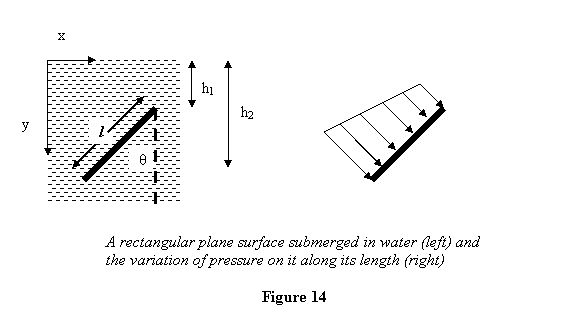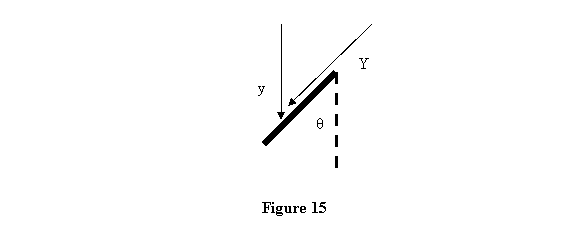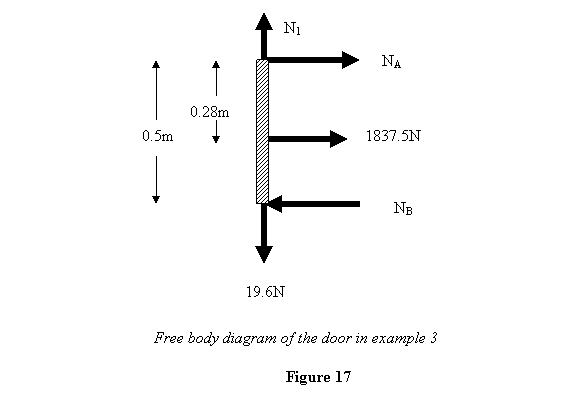As the next example of the application of the concepts
developed, we wish to calculate forces on plane rectangular
surfaces submerged in water.
Plane surface Submerged in water: Two
questions we wish to answer are (i) What is the average
pressure on the plate? and (ii) where does the total
force due to the pressure act? Consider a rectangular
plate of length l and width w submerged
in water at an angle θ from the vertical
as shown in figure 14. The upper end of the plate
is at the depth of h1 and the lower one at the depth
of h2 .

We first calculate the average pressure on the plate.
At a depth y the pressure acting on the plate is ρgy ,
where ρ is the density of water and g the
gravitational acceleration. If we now take a thin strip
of width dy at depth y parallel to
the plate's width, its area dA =  ,
and the force on it would be dF =
,
and the force on it would be dF =  .
The total force on the plate would therefore be
.
The total force on the plate would therefore be

This gives the average pressure to be

To understand the significance of the expression above
better, let us introduce another length variable Y along
the plate (see figure 15).

Then we have  so
that we can write the average pressure as
so
that we can write the average pressure as

However,  is
the Y-distance of the centroid of the plate. Let us call
it YC . Thus
is
the Y-distance of the centroid of the plate. Let us call
it YC . Thus

Or the average pressure on the plate is ρg( the
depth of the centroid of the plate ). We point
out that although we derived this result here for
a rectangular plate, the result for the average pressure
that  is
true for a planar surface of any shape. This is because
is
true for a planar surface of any shape. This is because  and
and  is
the Y-distance of the centroid of an area of any
shape.
is
the Y-distance of the centroid of an area of any
shape.
Question that we ask now is: at what point does the total
force act? To see this let us calculate the moment of
the distributed forces due to the pressure. This is given
by

where

For a rectangular plate,  ,
which is independent of Y. So the loading intensity (force
per unit length) for a rectangular plate is going to
have the same dependence on the depth as the pressure.
Thus the loading on a rectangular plate is trapezoidal
as shown in figure 14. The Y-coordinate of the point
at which the force acts is
,
which is independent of Y. So the loading intensity (force
per unit length) for a rectangular plate is going to
have the same dependence on the depth as the pressure.
Thus the loading on a rectangular plate is trapezoidal
as shown in figure 14. The Y-coordinate of the point
at which the force acts is

This by definition is the centroid of the area formed
by the loading intensity curve. You have already calculated
the centroid of a trapezoidal loading curve. Using that
result we find that the total force acts at a depth of

Using this result we now solve one example.
Example 4: A two meter high water tank
has an opening of the size  at
the bottom. The opening is covered by a door hinged on
top, shown by A, and is stopped by a fixed wedge, shown
by B, at the bottom (see figure 16). Calculate the force
on A and B (a) when tank has water filled up to 1m, and
(b) has 25cm of water in it. Weight of the door is 19.6N.
at
the bottom. The opening is covered by a door hinged on
top, shown by A, and is stopped by a fixed wedge, shown
by B, at the bottom (see figure 16). Calculate the force
on A and B (a) when tank has water filled up to 1m, and
(b) has 25cm of water in it. Weight of the door is 19.6N.

(a) As derived earlier, the average pressure
on the door will be given by the depth of its
centroid. The centroid of the square is at a depth of
(0.5 + 0.25 = 0.75m) from the surface of the water. Thus
the average pressure is


Thus the total force is
F=7350 × .25m 2 =1837.5 N
Notice that having derived our general result for the
average pressure earlier, we do not have to perform
any integration again to calculate the total force; it
is simply the average pressure times the total area.
The force is acting at a depth of

In the present case h1 = 0.5m , h2
= 1.0m .
This gives that the total force is acting at a depth
of  or 0
.28m below A. Thus the free body diagram of the
door looks as follows
or 0
.28m below A. Thus the free body diagram of the
door looks as follows

From the force balance equations we have
NA +NB = 1837.5
and
N1 = 19.6N
The torque balance equation, on the other hand, gives
.5N B = .28 x 1837.5
This leads to NB = 1029 N . Putting
this in the force balance equation above gives NA
= 805.5 N. Thus all the forces have been calculated.
(b) In the second case, the pressure works only on a part
of the door and the loading due to the pressure is triangular.
Having given this lead to the solution, I'll leave the
rest of the problem for you to work out. The answers
are NA = 25.425 N, NB = 127.7 N
and N1 = 19.6 N.
To summarize, in this lecture we have looked at some properties
a plane and used it in statics problems. In the
next lecture we will expand on this and develop concepts
of moment of area and products of area etcetera.